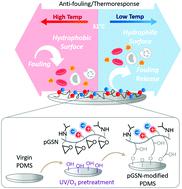当前位置:
X-MOL 学术
›
J. Mater. Chem. B
›
论文详情
Our official English website, www.x-mol.net, welcomes your
feedback! (Note: you will need to create a separate account there.)
Temperature-triggered attachment and detachment of general human bio-foulants on zwitterionic polydimethylsiloxane
Journal of Materials Chemistry B ( IF 6.1 ) Pub Date : 2020-08-25 , DOI: 10.1039/d0tb01478h Christian Martin E. Tan, Gian Vincent Dizon, Sheng-Han Chen, Antoine Venault, Ying-Nien Chou, Lemmuel Tayo, Yung Chang
Journal of Materials Chemistry B ( IF 6.1 ) Pub Date : 2020-08-25 , DOI: 10.1039/d0tb01478h Christian Martin E. Tan, Gian Vincent Dizon, Sheng-Han Chen, Antoine Venault, Ying-Nien Chou, Lemmuel Tayo, Yung Chang

|
Biofouling has long been a problem for biomaterials, so being able to control the fouling on the surface of a biomaterial would be ideal. In this study a copolymer system was designed comprising three moieties: an epoxy containing group, glycidyl methacrylate (GMA); a thermoresponsive segment, N-isopropylacrylamide (NIPAAm); and an antifouling zwitterionic unit, sulfobetaine methacrylate (SBMA). The copolymers (pGSN), synthesized via free radical polymerization with these 3 moieties, were then grafted onto polydimethylsiloxane (PDMS). The presence of a critical temperature for both the copolymers and the coated PDMS was evidenced by particle size and contact angle measurements. The coated PDMS exhibited controllable temperature-dependent antifouling behaviors and stimuli-responsive phase characteristics in the presence of salts. The interactions of the coated PDMS with biomolecules were tested via attachment of fibrinogen protein, platelets, human whole blood, and tumor cells (HT1080). The attachment and detachment of these biomolecules were studied at different temperatures. Exposed hydrophobic domains of thermoresponsive NIPAAm-rich pGSN containing NIPAAm at 56 mol% generally allows molecular and cellular attachment on the PDMS surface at 37 °C. On the other hand, the coated PDMS with a relatively high content of SBMA (>41 mol%) in the copolymer started to exhibit fouling resistance and lower the thermoresponsive properties. Interestingly, the incorporation of zwitterionic SBMA units into the copolymers was found to accelerate the hydration of the PDMS surfaces and resulted in biomolecular and cellular detachment at 25 °C, which is comparable to the detachment at 4 °C. This modified surface behavior is found to be consistent through all biofouling tests.
中文翻译:

温度触发的普通人类生物污垢物在两性离子聚二甲基硅氧烷上的附着和脱离
生物污垢一直是生物材料的问题,因此能够控制生物材料表面的污垢将是理想的。在这项研究中,设计了一种共聚物体系,该体系包含三个部分:一个含环氧基的甲基丙烯酸缩水甘油酯(GMA);热响应链段,N-异丙基丙烯酰胺(NIPAAm);和一个防污两性离子单元,甲基丙烯酸磺基甜菜碱(SBMA)。共聚物(pGSN),通过然后将具有这3个部分的自由基聚合反应接枝到聚二甲基硅氧烷(PDMS)上。共聚物和涂覆的PDMS两者都存在临界温度,这通过粒度和接触角测量来证明。在盐的存在下,涂覆的PDMS表现出可控制的温度依赖性防污行为和刺激响应相特征。包被的PDMS与生物分子的相互作用通过纤维蛋白原蛋白,血小板,人全血和肿瘤细胞的附着(HT1080)。在不同温度下研究了这些生物分子的附着和分离。含有56 mol%NIPAAm的富含NIPAAm的热响应性pGSN的疏水域通常允许在37°C下分子和细胞附着在PDMS表面上。另一方面,在共聚物中具有相对较高的SBMA含量(> 41mol%)的涂覆的PDMS开始显示出耐污染性并降低了热响应性。有趣的是,发现将两性离子SBMA单元掺入共聚物可加速PDMS表面的水合作用,并导致25°C的生物分子和细胞脱离,这与4°C的脱离相当。
更新日期:2020-10-07
中文翻译:

温度触发的普通人类生物污垢物在两性离子聚二甲基硅氧烷上的附着和脱离
生物污垢一直是生物材料的问题,因此能够控制生物材料表面的污垢将是理想的。在这项研究中,设计了一种共聚物体系,该体系包含三个部分:一个含环氧基的甲基丙烯酸缩水甘油酯(GMA);热响应链段,N-异丙基丙烯酰胺(NIPAAm);和一个防污两性离子单元,甲基丙烯酸磺基甜菜碱(SBMA)。共聚物(pGSN),通过然后将具有这3个部分的自由基聚合反应接枝到聚二甲基硅氧烷(PDMS)上。共聚物和涂覆的PDMS两者都存在临界温度,这通过粒度和接触角测量来证明。在盐的存在下,涂覆的PDMS表现出可控制的温度依赖性防污行为和刺激响应相特征。包被的PDMS与生物分子的相互作用通过纤维蛋白原蛋白,血小板,人全血和肿瘤细胞的附着(HT1080)。在不同温度下研究了这些生物分子的附着和分离。含有56 mol%NIPAAm的富含NIPAAm的热响应性pGSN的疏水域通常允许在37°C下分子和细胞附着在PDMS表面上。另一方面,在共聚物中具有相对较高的SBMA含量(> 41mol%)的涂覆的PDMS开始显示出耐污染性并降低了热响应性。有趣的是,发现将两性离子SBMA单元掺入共聚物可加速PDMS表面的水合作用,并导致25°C的生物分子和细胞脱离,这与4°C的脱离相当。











































 京公网安备 11010802027423号
京公网安备 11010802027423号